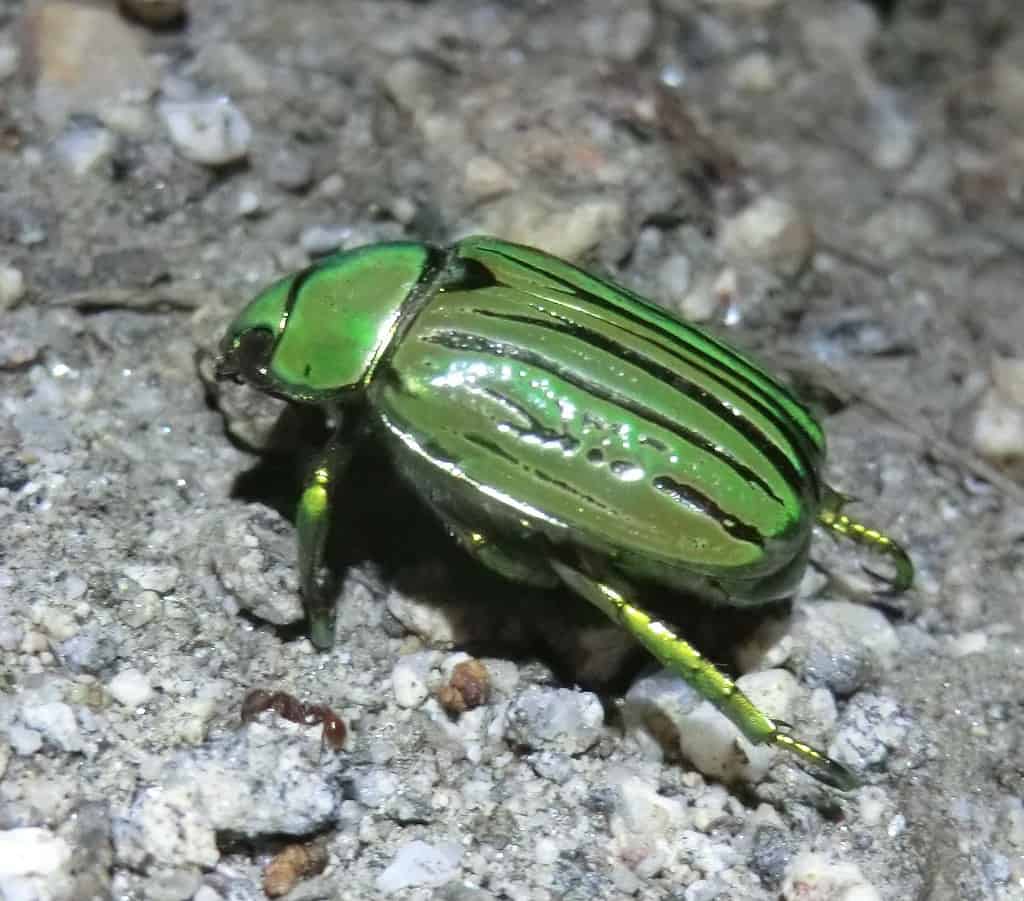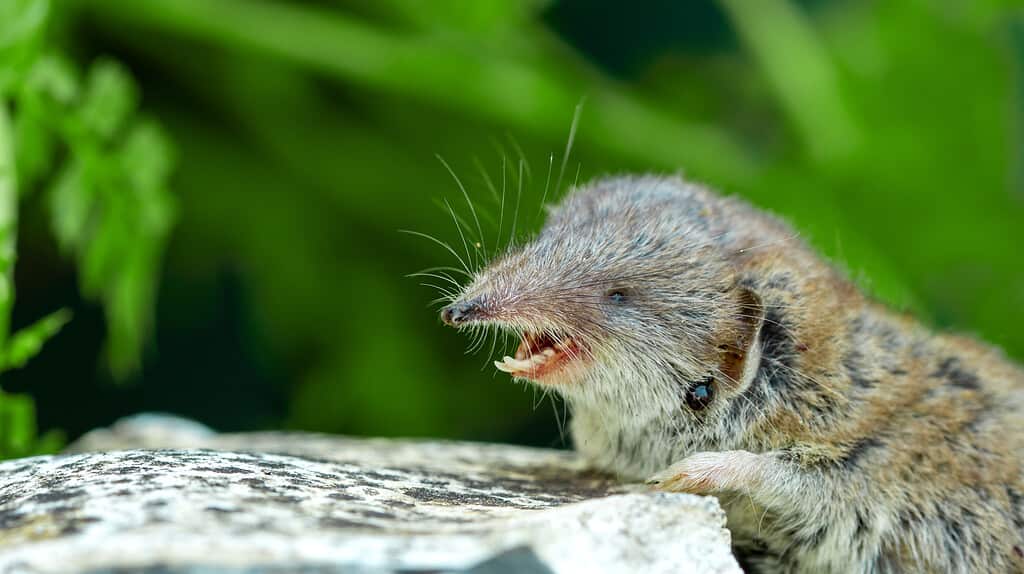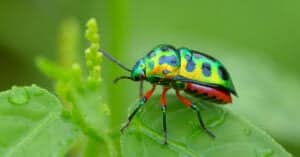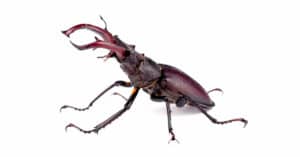The world of insects is filled with an incredible array of fascinating species. Each has its own unique characteristics and adaptations. Among these captivating creatures is the rainbow beetle.
The beetle’s iridescent exoskeleton, which displays an array of vibrant colors, has captured the attention of scientists, nature enthusiasts, and the general public alike.
The rainbow beetle is not only an aesthetically pleasing insect but also plays a vital role in maintaining the health of the ecosystems it inhabits. As decomposers and nutrient recyclers, these beetles contribute to the natural processes that sustain life on Earth.
In this article, we will delve into the fascinating world of the rainbow beetle, exploring its taxonomy, physical characteristics, habitat, diet, predators, reproduction, conservation status, and threats.

Commonly, this insect is referred to as the glorious beetle or rainbow scarab, both names emphasizing its captivating appearance.
©Brian Magnier/Shutterstock.com
What Is It Called?
The scientific name for the rainbow beetle is Chrysina gloriosa, reflecting both its striking appearance and its place within the insect world.
The genus name “Chrysina” is derived from the Greek word “chrysos,” meaning gold, while the species name “gloriosa” means glorious or magnificent in Latin, aptly describing the beetle’s iridescent exoskeleton.
Commonly, this insect is referred to as the glorious beetle or rainbow scarab, both names emphasizing its captivating appearance.
Origins of the Name
The etymology and history of the rainbow beetle’s name can be traced back to the admiration of its stunning coloration, which has captivated observers for centuries.
The association with gold and glory in its scientific name highlights the esteem with which this insect has been regarded.
The common name of “rainbow scarab” links it to the broader family of Scarabaeidae and its diverse members.
Overall, the rainbow beetle’s nomenclature reflects both its visual appeal and connections to the broader insect world.
Scientific Classification
The rainbow beetle belongs to the vast and diverse group of animals known as arthropods, including insects, arachnids, crustaceans, and more.
Within the arthropods, the rainbow beetle is classified as an insect, specifically a member of the order Coleoptera, which encompasses all beetles.
The rainbow beetle’s family is Scarabaeidae, a large and diverse group of beetles that includes dung beetles, rhinoceros beetles, and Egyptian scarabs.
Physical Description and Characteristics

One of the most striking features of the rainbow beetle is its iridescent exoskeleton.
©1208 Jewel Scarab – Chrysina gloriosa Uploaded by Magnus Manske – License
The rainbow beetle is a visually stunning insect that exhibits various unique physical features.
Size and Shape
Rainbow beetles are medium-sized insects, with adults typically measuring 0.8-1.2 inches long.
Their bodies are stout and oval-shaped, with robust legs adapted for burrowing and climbing. The beetle’s exoskeleton is thick and durable. This provides protection against predators and environmental hazards.
Iridescent Exoskeleton
One of the most striking features of the rainbow beetle is its iridescent exoskeleton, which displays a dazzling array of colors, including shades of green, blue, gold, and violet.
This iridescence is a result of structural coloration, a phenomenon that occurs when microscopic structures within the exoskeleton interfere with light, producing the vibrant colors observed.
The exact mechanism behind this structural coloration involves layers of chitin and air within the exoskeleton, which reflect and refract light, creating the stunning visual effect.
Other Notable Features
In addition to its colorful exoskeleton, the rainbow beetle possesses several other noteworthy characteristics.
Its antennae are of the lamellate type, which means they consist of a series of leaf-like plates that can be fanned out or compacted, allowing the beetle to effectively detect chemical signals in its environment.
The legs of the rainbow beetle are equipped with sharp claws. They enable it to grip and navigate various surfaces, including tree bark and rocky terrain.
Lastly, the beetle is capable of flight, with membranous wings folded beneath its hardened forewings, or elytra. These wings can be rapidly unfurled, allowing the beetle to take to the air in search of food or to escape potential threats.
Where Do They Live?
The distribution and preferred habitats of the rainbow beetle are essential factors influencing its behavior, diet, and overall survival.

They thrive in the leaf litter, decaying wood, and other organic materials that provide their primary food sources.
©iStock.com/Pictures-and-Pixels
Geographic Range
The rainbow beetle is primarily found in Central America and the southwestern U.S. Its range extends from Mexico to Arizona and New Mexico.
Within this geographic area, the beetle inhabits various ecosystems, demonstrating its adaptability and resilience to different environmental conditions.
Specific Environments
Rainbow beetles are typically found in both deciduous and coniferous forests. They thrive in the leaf litter, decaying wood, and other organic materials that provide their primary food sources.
They show a preference for habitats with moderate to high levels of humidity. They’re often in areas with consistent rainfall or near bodies of water.
Additionally, the beetles can be found at a range of elevations, from lowland forests to montane ecosystems, further highlighting their adaptability.
Factors Influencing Distribution
The distribution of the rainbow beetle is influenced by several factors, including:
- Climate
- Weather conditions
- The availability of food sources
Climate plays a significant role in determining the beetle’s range. It prefers habitats with moderate to high humidity and consistent rainfall.
Weather conditions can also impact the beetle’s distribution. For example, extreme temperatures or prolonged periods of drought may force the insects to seek out more favorable environments.
Finally, the availability of food sources plays a critical role in the distribution of the rainbow beetle. The sources include:
- Decaying plant matter
- Dung
- Carrion
The insects rely on these resources for their survival and reproduction.
Diet and Feeding Habits
Understanding the diet and feeding habits of the rainbow beetle is crucial for appreciating its ecological role and the factors that influence its survival and reproduction.

The rainbow beetle is primarily a detritivore, feeding on decaying plant matter.
©Roberto Michel/Shutterstock.com
Primary Food Sources
The rainbow beetle is primarily a detritivore, feeding on decaying plant matter, such as:
- Fallen leaves
- Rotting wood
- Decomposing fruits
The beetle also consumes dung and carrion, making it an important scavenger in its ecosystems.
Its powerful mandibles enable it to efficiently break down and consume various organic materials. This provides it with the necessary nutrients to sustain its growth and reproduction.
Role in the Ecosystem
As decomposers and nutrient recyclers, rainbow beetles play a vital role in the ecosystems they inhabit.
By breaking down decaying plant matter, dung, and carrion, they contribute to the recycling of nutrients and the formation of nutrient-rich soil. This process helps support the growth of plants that provide food and shelter for various organisms.
Additionally, rainbow beetles serve as a food source for various predators. They include birds, reptiles, small mammals, and other insects, making them an integral part of the food web within their ecosystems.
Predators
The rainbow beetle, like all organisms, faces various threats from predators in its environment.

Shrews are a common predator of the rainbow beetle.
©Mabeline72/Shutterstock.com
Common Predators of the Rainbow Beetle
Rainbow beetles face predation from various organisms within their ecosystems. They include:
- Birds. Birds, with their keen eyesight and ability to capture insects in flight or on the ground, are among the most common predators of the rainbow beetle.
- Reptiles. Reptiles, such as lizards and snakes, also prey upon these beetles, taking advantage of their ground-dwelling habits.
- Small mammals. Small mammals, like shrews and rodents, may also consume the beetles when encountered.
- Other invertebrates. Additionally, the rainbow beetle faces threats from other invertebrates, such as predatory insects and arachnids, which may target both adult beetles and their larvae.
Defense Mechanisms against Predators
To protect themselves from predation, rainbow beetles employ various defense mechanisms. They include:
- Camouflage and mimicry. Camouflage and mimicry are essential strategies for these beetles to avoid detection. The iridescent exoskeleton of the rainbow beetle can serve as a form of camouflage, as it reflects the colors of the surrounding environment, making the beetle less conspicuous to potential predators.
- Passive defenses. The beetles may also exhibit passive defenses, such as remaining still when a predator is nearby or attempting to hide within leaf litter or other debris.
- Active defenses. Active defenses employed by the rainbow beetle include using their strong mandibles and legs to fend off predators. In some cases, the beetles may also use their wings to create a buzzing sound, which can startle or deter predators. These various defense mechanisms enable the rainbow beetle to minimize the risk of predation and increase its chances of survival in the wild.
Reproduction and Lifecycle
The reproduction and lifecycle of the rainbow beetle are essential aspects of its biology. It influences its behavior, population dynamics, and role in the ecosystem.
Mating Behavior and Rituals
Rainbow beetles typically engage in mating behaviors during the warmer months, when food is abundant and environmental conditions are favorable for reproduction.
Males may use their antennae to detect pheromones released by females, which serve as cues for locating potential mates.
Once he locates a suitable mate, the male may perform courtship rituals. This includes rubbing or tapping the female with his antennae, to stimulate her interest and receptivity.
Oviposition and Larval Development
After mating, female rainbow beetles lay their eggs in the soil or within decaying plant material, such as rotting logs or leaf litter.
This choice of oviposition site ensures that the hatching larvae have immediate access to food sources. The larvae of the rainbow beetle are grub-like in appearance, with soft, segmented bodies and strong mandibles for consuming decaying organic matter.
As they grow and develop, the larvae undergo several molts, shedding their exoskeletons to accommodate their increasing size.
Metamorphosis and Adult Emergence
Once the larvae of the rainbow beetle have reached a sufficient size, they enter a pupal stage, during which they undergo a complete metamorphosis.
Within the protective pupal case, the larva transforms into an adult beetle, developing its characteristic iridescent exoskeleton, wings, and other adult structures.
Upon completion of metamorphosis, the adult beetle emerges from the pupal case and begins its life as a fully developed insect, ready to forage, mate, and reproduce.
Lifespan and Mortality Factors
The lifespan of the rainbow beetle can vary depending on factors such as:
- Environmental conditions
- Food availability
- Predation pressure
In general, these beetles have a relatively short lifespan, with most individuals living for several months to a year.
Mortality factors affecting the rainbow beetle can include:
- Predation
- Competition for resources
- Disease
- Unfavorable environmental conditions, such as extreme temperatures or drought

The rainbow beetle, with its iridescent exoskeleton and captivating appearance, is a remarkable insect that captures the imagination of both scientists and nature enthusiasts alike.
©https://www.flickr.com/photos/cogdog/27916990653/ – License
Conservation Status and Efforts
The conservation status of the rainbow beetle is an important consideration. It highlights the need for protection and management efforts to ensure the long-term survival of this captivating insect.
Current Conservation Status
As of now, the rainbow beetle is not on the endangered or threatened species list by conservation organizations.
But the beetle’s populations can be influenced by various factors, including:
- Habitat loss and fragmentation
- Climate change
- Human activities
It’s essential to monitor the distribution and abundance of the rainbow beetle to ensure that its populations remain stable and viable in the face of ongoing environmental change.
Conservation Efforts
While the rainbow beetle isn’t currently a threatened species, efforts to conserve its habitat and protect its populations are still essential. These efforts include:
- Restoring and preserving habitats
- Establishing protected areas
- Implementing sustainable land-use practices that minimize the impacts of human activities on the beetle’s environment
Additionally, research and monitoring of the rainbow beetle’s populations, distribution, and biology can help inform conservation efforts and guide the development of effective management strategies.
Key Takeaways
The rainbow beetle, with its iridescent exoskeleton and captivating appearance, is a remarkable insect that captures the imagination of both scientists and nature enthusiasts alike.
By exploring its taxonomy, physical characteristics, habitat, diet, predators, reproduction, and conservation status, we gain a deeper understanding of the beetle’s biology, ecological role, and the factors that influence its survival.
While not currently listed as a threatened species, they face several challenges that warrant ongoing monitoring and conservation efforts. Through research, habitat preservation, and sustainable land-use practices, we can help ensure the long-term survival of this extraordinary insect and its role in maintaining healthy and diverse ecosystems.
The photo featured at the top of this post is © GypsyPictureShow/Shutterstock.com
Thank you for reading! Have some feedback for us? Contact the AZ Animals editorial team.






